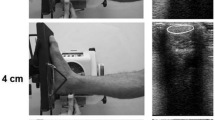Abstract
As a part of a major experimental study of forces in muscles and tendons it became necessary, as a preliminary step, to know the stress-strain relationship in human tendon. The studies reported herein give data from thirty tests on cadaveric human plantaris tendon in three states, i.e., moist, air dried and oven dried. Results are correlated with previously published results on tendon and with published strengths of human muscle and bone. Considerable new information on tendon strength is presented and several important deductive conclusions are given. The equipment and methods are described and illustrated and an appendix is given, showing results of the individual tests.
Sommaire
En abordant une large étude expérimentale sur les forces agissant dans les muscles et les tendons, une étude préliminaire de la relation charge-tension s’est avérée nécessaire. Le présent exposé porte sur l’information recueillie à partir de 30 expériences faites sur le tendon plantaire humain, prélevé par autopsie. Ces expériences ont été menées dans des conditions différentes: tendon humide, tendon séché à l’air, tendon séché à l’étuve. Une corrélation a été etablie entre les résultats ainsi obtenus et ceux publiés précédemment sur le comportement des tendons et sur les mesures déjà établies des forces agissant dans le muscle et le tendon. Un nombre considérable de renseignements nouveaux concernant la force du tendon est fourni par la présente étude, et plusieurs conclusions significatives en sont tirées par déduction. L’équipement et les méthodes employés y sont également décrits et illustrés.
Zusammenfassung
Bei einer größeren experimentellen Untersuchung über die in Muskeln und Sehnen wirkenden Kräfte, erwies sich eine Kenntnis des Verhältnisses Belastung-Spannung in menschlichen Sehnen als unerläßlich. Die hier vorliegenden Studien bringen Daten aus über 30 Testfällen mit sezierten Sohlensehnen in drei verschiedenen Zuständen: feucht, luftgetrocknet und ofengetrocknet. Die Ergebnisse werden mit kürzlich veröffentlichten Erkenntnissen über Sehnen und mit Angaben über die Stärke von menschlichen Muskelgeweben und Knochen in Beziehung gebracht. Es werden neue Informationen über Sehnenstärke und einige Folgerungen dargestellt. Die Versuchsanordnung und die Methoden werden beschrieben und abgebildet.
Резюме
Для намечаемого исследования сил в мыщпах и сухожилиях необходимо в качестве предварительной ступени изучить отношение нагрузка-деформация для сухожилия человека. Сообщенные данные относятся к тридцати испытаниям плантарного сухожилия трупов, проведенным для трех состояний; влажнного, высушенного на воадухе и высушенного в сушильной печи. Результаты сопоставляются с ранее опубликованными данными о сухожилиях и прочности мыпц и костей человека. Представлены существенно новые сведения о прочности сухожилий и даны некоторые важные выводы. Описаны и иллюстрированы оборудование и методы.
Similar content being viewed by others
References
Braams, R. (1960) The effect of electron radiation on the tensile strength of tendon.Int. J. Radiat. Biol.,4, 27–31.
Calabrisi, P. andSmith, F. C. (1951) The effect of embalming on the compressive strength of a few specimens of compact human bone. Naval Medical Research Institute, memorandum Report 51-2. NM 000-018. 07.02, National Naval Medical Center, Bethesda.
Cronkite, A. E. (1936) The tensile strength of human tendons.Anat. Rec.,64, 173–186.
Davidsson, L. (1954) Tensile strength, rupture and regeneration of tendons.Ann. Chir. Gynaec. Fenn.,43, (Suppl.)5, 61–66.
Evans, F. G. andLebow, M. (1952) The strength of human compact bone as revealed by engineering technics.Amer. J. Surg.,83, 326–331.
Gerston, J. W. (1955) Effect of ultrasound on extensibility of tendon.Amer. J. Phys. Med.,34, 362–369.
Hill, A. V. (1956) Design of muscles.Brit. med. Bull.,12, 165–166.
Koch, J. C. (1917) The laws of bone architecture.Amer. J. Anat.,21, 177–294.
McMaster, P. E. (1933) Tendon and muscle ruptures: Clinical and experimental studies on causes and location of subcutaneous ruptures.J. Bone Jt. Surg.,15, 705–722.
Author information
Authors and Affiliations
Rights and permissions
About this article
Cite this article
Walker, L.B., Harris, E.H. & Benedict, J.V. Stress-strain relationship in human cadaveric plantaris tendon: A preliminary study. Med. Electron. Biol. Engng 2, 31–38 (1964). https://doi.org/10.1007/BF02474358
Received:
Accepted:
Issue Date:
DOI: https://doi.org/10.1007/BF02474358




